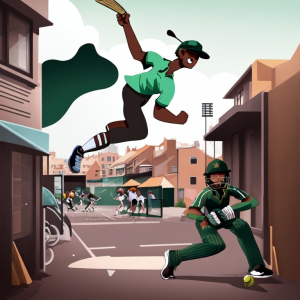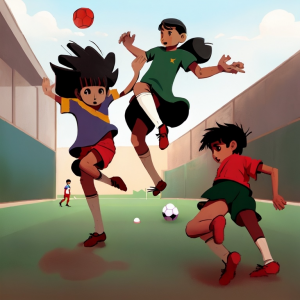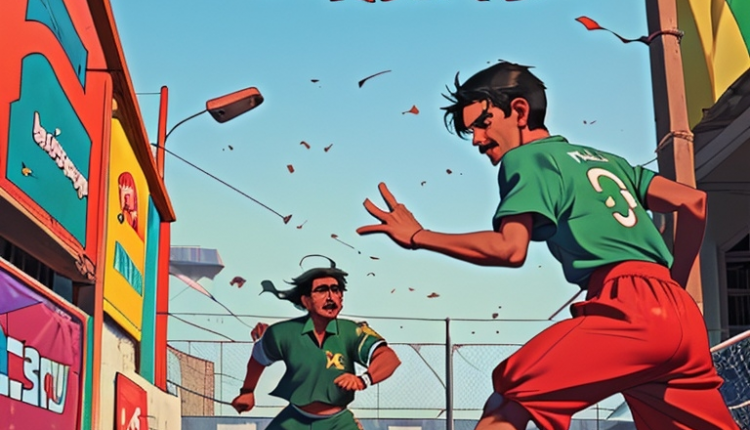The Good Old Days of Street Sports in Pakistan
Reliving the Glory Days of Street Sports in Pakistan: No Wi-Fi, Just Pure Fun
Ah, the ‘90s. A time when the world was a bit slower, simpler, and oh-so-much more exciting. The internet was still a far-off dream, social media was unheard of, and kids actually went outside to play. Imagine that! If you were lucky enough to grow up in the ‘90s in Pakistan, your childhood was probably filled with endless hours of running around the streets, playgrounds, and school grounds, playing games that didn’t require a Wi-Fi connection, just the power of imagination and a lot of energy. Let’s take a little stroll down memory lane, shall we?
The Streets Were Our Playground
There was something magical about those days when our streets were our playgrounds. The only rules were those that were made up on the spot, and every corner of the street was an opportunity for mischief and fun. The most classic scene? The one where a bunch of kids would gather in front of a house, calling out to their friends with a mix of excitement and defiance as their parents yelled from the balconies, warning them to be home by sunset. But who cared? Sunset was hours away, and there were games to be played.
Now, let’s talk about the street sports. Cricket was an absolute obsession. It wasn’t just a sport; it was a religion. Streets transformed into makeshift cricket pitches, where a broomstick served as the stumps, and the tennis ball was the most cherished possession. You didn’t need a proper bat – any old piece of wood would do. And don’t even get me started on the “one tap” rule. The thrill of a cricket match that could last for hours, with everyone playing for pride, not glory – that was the spirit. It didn’t matter if your ‘pitch’ was made of concrete, dirt, or the occasional pothole – a game was a game.
Remember the thrill of running home as soon as the ball went over the street? “Chakka!” you’d shout, and your friends would groan, but the next day, it’d all happen again. That’s the thing about street cricket – it wasn’t about the perfect play; it was about the experience, the camaraderie, and the sheer joy of a good game, no matter how many windows you broke along the way (sorry, Auntie Neelam).
The All-Time Street Game: Gully Cricket
If you grew up in Pakistan, you’ve probably spent at least 80% of your childhood playing gully cricket. What’s gully cricket, you ask? Well, it’s exactly what it sounds like: cricket in the alleyways, the narrow streets, or wherever a group of enthusiastic kids could gather. The setup was simple: one person acted as the bowler, one as the batter, and everyone else formed a ragtag team of fielders – often using makeshift boundaries marked by shoes or stray pieces of cloth.

The real beauty of gully cricket wasn’t just the game itself, though. It was the preparation. The hunt for that perfect tennis ball, the search for a bat that didn’t resemble a plank, and the negotiation over whose turn it was to bowl. If you were lucky, someone had a ball that wasn’t too worn out, and the sound of it hitting the concrete felt like music to your ears.
You could spend hours playing, sometimes well into the evening, with only the faint light of street lamps guiding your way. And when the game was over? Oh, the excitement of recounting every run, every shot, and of course, that one unbelievable catch that no one would ever stop talking about.
Football, the Game of Dreams
And who could forget football? The sport that didn’t require a bat, a ball, or much equipment, just a flat surface and a group of friends. Whether it was a dusty lane, a patch of grass near the park, or even the open field of a school, football was a rite of passage.
But here’s the thing: no one had fancy shoes or uniforms – it was all about who had the most stamina and who could kick the hardest. The goalposts? A pair of sandals or shoes, often mismatched, but perfectly adequate. The excitement was palpable. We’d all line up, ready to take that penalty shot, only to have the ball miss by an inch (or smash into a passing car – oops).
In our imaginations, we were all Messi or Ronaldo, even though in reality, the only thing we shared with them was the dream of scoring the perfect goal. The dirt-streaked faces, the bruised knees, and the stories of that one goal that almost happened were what made it all so unforgettable. Football wasn’t just a game; it was the embodiment of freedom.

The Iconic Games of Our Childhood
Let’s not forget the games we played at school – the ones that made our lunch breaks legendary. The simple joys of playing pitthoo, also known as seven stones, where the goal was to knock down a pile of stones with a ball and then try to rebuild it while avoiding being hit by the same ball. Talk about being the last person standing! The rush of adrenaline when you were on the field, weaving in and out of the other team’s attempts to hit you – it was life at its finest.
And who didn’t enjoy a good round of kabaddi? A sport that required both strategy and sheer muscle, where the idea was simple: enter enemy territory, tag someone, and run back to your side before they caught you. It was a game that could get as rough as it was hilarious, but we were all up for it – bruises and all.
The other quintessential playground game was ludo – not on a digital screen, but played on the floor, often with cousins and friends, in a battle of wits and luck. Then there was kho-kho, which was an absolute thrill for those who could run fast and dodge quick, and chhupam chhupai (hide and seek), where the best part wasn’t just hiding but the chase after it.
School Sports Day – The Battle for Glory
School sports days were another big part of the 90s childhood. Oh, the excitement of being chosen for the 100-meter race or the relay event! It wasn’t just about winning – it was about the hype, the cheers from classmates, and the collective anticipation of who would come first. Remember the practice sessions? How we’d run around the school grounds pretending to be Olympians, competing for that elusive first-place ribbon.
And then there was the feeling of victory – the sweet, unmatchable thrill of crossing the finish line, your legs burning, your lungs on fire, and then the feeling of being lifted on your friends’ shoulders because, of course, you had just won the race for your team. It was all about that one moment when the crowd would erupt, and you were the hero.
The Digital Revolution: When Sports Started to Fade
And then, like all good things, the times began to change. The internet crept in slowly, then took over. With mobile phones, video games, and social media, the once lively streets became quieter, and the playgrounds that once echoed with the sounds of excited children began to fade into the background.
It wasn’t an instant shift – it was gradual, sneaky even. We’d still play cricket or football on weekends, but the intensity of those street games, the unrestrained joy of an impromptu match, began to diminish as screens started to take over our attention. Yet, there’s still something magical about those memories of days without phones, without Facebook, when our playgrounds were the streets, and our competition was fierce, raw, and totally unplugged.
The Lasting Impact
The beauty of those days lies in the simplicity of the games. There were no professional coaches, no high-tech gadgets to monitor our fitness – just our imagination and our raw energy. These games were not just sports; they were the fabric of our childhood, the moments that made us who we are today. Every bruise, every goal, every “chakka” yelled out in glee remains etched in our hearts.
As much as technology and the internet have taken over our lives, there’s still a little part of us that longs for those simpler times when the streets were our playground, and sports were all about the thrill of the game, not the followers or likes. Because let’s face it, no social media post will ever compare to the pure excitement of a game of gully cricket under the setting sun.

